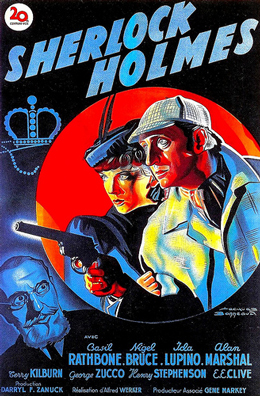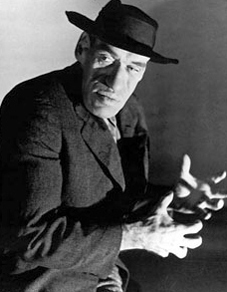
 |
|
|
|
Sir Arthur Conan Doyle's Sherlock Holmes ranks among the most popular and successful literary characters ever invented. Film adaptations of Doyle's stories have been done in several languages, and not a decade goes by without some new attempt to revive the franchise with a new cast. Of all the actors to play Sherlock Basil Rathbone is still considered the favorite. Rathbone's impersonatinon captures the 'consulting detective's' dynamism and charm, and he can be very convincing when exercising the detective's powers of reasoning, logic and intellect. Somehow, when Rathbone's Sherlock enters a room and introduces himself by deducing something unusual about a person he's meeting, he comes off as a super-competent genius, and not an Edwardian boor. It's not like Mr. Deerstalker & pipe didn't have box office competition, as American screens in the early 1940s were overrun with film series about clever detectives solving tricky crimes. Series with Mr. Moto, Torchy Blane, and Nancy Drew were winding up, but Nick and Nora Charles were still in business, along with Philo Vance, Charlie Chan, The Crime Doctor, and The Saint. None had quite the charisma of Sherlock Holmes, whose fame was such that many probably thought he was an actual historical personage. On paper, Holmes spent his time protecting the rights of the wealthy against upstarts from the lower classes, gradually drifting into more of an intellectual pulp hero doing combat with his arch nemesis Professor Moriarty. Sherlock's appeal translated into many languages and cultures, wherever readers warmed to the idea of rationality restoring order to chaos -- Holmes was wildly popular in Germany, for instance.

The fourteen Sherlock Holmes adventure movies released by Fox and Universal between 1939 and 1946 see the genius of Baker Street put to work in some unusual ways, especially when the detective is enlisted to contend with Nazi villains half a century away from his proper time frame. But Rathbone remains true to the character no matter how absurd things may get. The jury is probably still out on Nigel Bruce's Dr. Watson. Watson functioned mostly as a passive observer/narrator in the original Doyle stories. In the film series he increasingly becomes a source of comic relief, more of a bumbling millstone than a collaborator for Sherlock. Fortunately, nobody bumbles like Nigel Bruce bumbles... whenever we see Bruce in another film, we automatically think of the good doctor. MPI has gathered all fourteen of the features in Sherlock Holmes: The Complete Collection, a Blu-ray box that improves on their DVD set of several years ago. Viewers unfamiliar with the films will find that they play like a disjointed but appealing miniseries. Beyond Rathbone and Bruce, the appeal of the films is their mix of serviceable-to-good mysteries, atmospheric sets photography and enjoyable supporing players. When seen in HD, we can really appreciate the classy production values that Universal lavished on even their most budget-conscious features. The most oft-filmed Holmes adventure is The Hound of the Baskervilles (1939), which has some of the qualities of a good horror story. Fox's adaptation is fairly faithful, if not as exciting or as tense as the quirky 1958 Hammer version with Peter Cushing. Spooky supporting parts are filled by horror veterans John Carradine and Lionel Atwill. Even though Richard Greene receives top billing, Rathbone and Bruce were instantly recognized as a solid team. Actress Mary Gordon would play the landlady Mrs. Hudson in all the films. This is the film that somehow escaped the censors with a blatant reference to Sherlock's cocaine habit: Rathbone can be heard to say "Watson, the needle!" just before the fade out. The Adventures of Sherlock Holmes (1939) is a mostly new concoction derived from a play based on two separate Doyle stories. It's probably the best film of the bunch for overall excitement and appeal. Sherlock tries to prevent the arch-criminal Professor Moriarty (George Zucco) from pulling off the crime of the century, and is distracted by another mystery involving beautiful Ann Brandon (Ida Lupino). This is the show where Rathbone introduced the catch phrase "Elementary, my Dear Watson". 
Despite the popularity of these first two Fox pictures, Sherlock & Watson were absent from screens for three years while studios bargained for the rights with the Doyle estate. Universal won the bidding, and the license to the characters and 21 stories for seven years (after the exercising of an option in mid-series). Universal churned out twelve more films at an average of 2.5 per year. Their changes to the formula veered far afield from the orginal stories, but audiences didn't care as Rathbone and Bruce's heroic screen characters remained consistent. Sherlock Holmes and the Voice of Terror (1942) was directed by John Rawlins, but the director for all the rest would be Roy William Neil. The obvious change was making Holmes a contemporary character, allowing him to battle Nazis, in this case, a network of German saboteurs guided by a "Voice of Terror" who interrupts radio broadcasts to boast of his next outrage. Evelyn Ankers, Reginald Denny, Thomas Gomez and Henry Daniell fill supporting roles. It's surprising how easy it is to accept Holmes in 1940s London. I suppose part of the appeal is that England is calling on its legendary heroes to save the nation, at least in fantasy terms. With Sherlock Holmes and the Secret Weapon (1942) the Universal series hit its stride. Director Neil pours on the atmospheric exteriors. The secret weapon of the title is an Allied bombsight that Professor Moriarty (Lionel Atwill, this time) wants to sell to the fascist enemy. The frustrated Inspector Lestrade (Dennis Hoey) makes his debut in this show, which also contains another sly reference to Sherlock's drug habit. The pace picks up with Sherlock Holmes in Washington (1943), which sees Sherlock racing to America to keep some microfilm from the grubby hands of yet another team of Nazi spies. As if playing tag team with Lionel Atwill, George Zucco returns not as Moriarty but Heinrich Hinkle, a German spymaster. Sherlock Holmes Faces Death (1943) gives the Nazis a break, and instead calls on Sherlok to solve a family murder in a baronial English manor house. It's based on the Doyle story, The Musgrave Ritual. Hillary Brooke and Milburn stone are familiar faces, and Peter Lawford has a bit part as a sailor. 
Things heat up in Sherlock Holmes and the Spider Woman (1944), with the entrance of a villainess who kills with spider venom. Sherlock fakes his death as part of a gambit to prove that the victims are not suicides. The great actress Gale Sondergaard was so popular in the role that she returned in a 1946 non-sequel called The Spider Woman Strikes Back (marvelous title), a horror picture with Rondo Hatton. Although Hitler makes an appearance as a target in a carnival shooting gallery, the series would not return Sherlock to Nazi-fighting duty. We can only suppose that, with the Allies now winning on all fronts, fantasy war intrigues were no longer necessary. The series continued to exploit the horror film ambience with The Scarlet Claw (1944), in which Sherlock pursues a "phantom" killer in a Canadian village. It's the most popular Universal installment, as it plays like one of their monster movies -- effects man John Fulton even supplies a glowing phantom to creep throught the midnight forest fog. Cinematographer George Robinson photographed more than a few classic Universal horror entries. The murder mystery The Pearl of Death (1944) introduces Rondo Hatton as the strangest and saddest of all horror stars. With his face distorted by acromegaly, Hatton didn't need makeup. He plays the Hoxton Creeper, a hulking killer that he'd more or less reprise in House of Horrors and The Brute Man. Horror star Evelyn Ankers also appears in an atypical villain role. The Pearl of Death often played in syndicated TV horror packages back in the 1960s. Considered something of a letdown is The House of Fear (1945), a stock murder mystery from a Doyle story called The Five Orange Pips. One of the art directors was the famous Eugene Lourie, a refugee from Europe in the first years of a new English-language career. It's an okay picture that looks tame only in contrast to the previous three entries in the series. 
The Woman in Green (1945) is the first series entry after Universal picked up an extended option from the Doyle estate. More murders lead Sherlock and Watson to uncover a new scheme of Professor Moriarty's that includes blackmail and hypnosis. After playing small supporting roles in two earlier films, Henry Daniell finally gets center stage here as the Napoleon of Crime, Professor Moriarity. Rathbone would praise him in his autobiography as the most "delectably dangerous" actor to play the role. Hillary Brooke returns, this time as Moriarity's accomplice, Lydia Marlowe. Pursuit to Algiers (1945) and Terror By Night (1946) see Holmes and Watson on an ocean liner and a train, respectively, protecting a European prince and a fabulous jewel called The Star of Rhodesia. Terror is by far the better film, with some good cat-and-mouse intrigue aboard an Edinburgh-bound sleeper car. Holmes' opponent this time is a Moriarty henchman, Colonel Sebastian Moran. Inspector Lestrade is finally afforded some respect in this episode, but it was actor Dennis Hoey's last appearance in the series. The final series show is Dressed to Kill (1946), in which three music boxes contain a code telling the location of stolen printing plates for five-pound notes. Besides solving the puzzle, Holmes must defeat a gang of thieves. Changing tastes may have stopped the series, or more likely a change in front-office politics. In the immediate post-war period Universal became Universal-International and reconfigured its studio image. Director Roy William Neil died shortly after completing the moody noir Black Angel. In his autobiography, Rathbone expressed his dissatisfaction with the new dark thrillers and their amoral heroes. He blamed Mickey Spillane and his ilk for killing interest in Holmes as a character among younger audiences.
MPI's Blu-ray set of Sherlock Holmes: The Complete Collection is a fine set of these 70 year-old thrillers that have gone their separate ways. Universal sold the series outright in the 1950s, and three of the titles are said to be in the Public Domain. All but the first two Fox features were restored on film by the UCLA FIlm Archives, and a featurette on the restoration sees archivist Bob Gitt explaining which titles had to be rescued from non-original sources. To our surprise, all of the transfers are good, and more than half are excellent. Sherlock Holmes Faces Death might have the weakest transfer; it looks a little bit softer and grainier than the others. But even it doesn't look bad. The transfers aren't 100% pristine like some big studio work, but I didn't see any flaws that might detract from our enjoyment. Gitt explains that original logos and even a missing end title had to be re-grafted onto negatives that had been trimmed for TV use. Six of the titles have commentaries, with David Stuart Davies turning in several tracks. Richard Valley has a solo outing and appears with David Gregory and Patricia Morison on Dressed to Kill. MPI's original DVD releases included informative booklets with liner notes by the late Richard Valley; these are not included in the Blu-ray set. The discs also have trailers for about five of the Universal titles; still galleries; and some ancient film footage of Sir Arthur Conan Doyle.
On a scale of Excellent, Good, Fair, and Poor,
Sherlock Holmes: The Complete Collection Blu-ray rates:
Reviews on the Savant main site have additional credits information and are often updated and annotated with reader input and graphics. Also, don't forget the 2010 Savant Wish List. T'was Ever Thus.
Review Staff | About DVD Talk | Newsletter Subscribe | Join DVD Talk Forum |
| ||||||||||||||||||